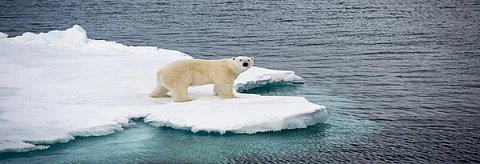

In another sign of the impact of climate change in the high Arctic, a total of 52 polar bears have gathered near Belushya Guba, the main settlement of Yuzhny Island, a part of the remote Novaya Zemlya archipelago in the Russian Arctic since December 2018.
Novaya Zemlya, made up of two main islands, the southern Yuzhny and the northern Severny, is located in the Arctic Ocean, between the Barents and Kara Seas. The archipelago is home to the world’s northern-most military base. The archipelago is home to 3,000 people, mostly ethnic Russians and indigenous Nenets.
Since December, the 52 bears have regularly visited Belushya Guba, with some displaying aggressive behaviour. They have entered homes, public buildings and the military garrison. Some have even attacked people, say media reports.
The authorities’ attempts to scare the bears away with vehicles and dogs are not working since the animals are no longer afraid.
On February 9, 2019, the authorities in charge of Novaya Zemlya declared a state of emergency.
Russia’s federal environmental resources agency has so far refused to issue licences to shoot the most aggressive bears.
A team of federal officials is on its way to Belushya to assess the situation. Authorities have reportedly been quoted as saying that if all fails, there would be a ‘bear cull’ and all the animals would be shot.
Ilya Mordvintsev, a lead researcher at the Severtsev Institute of Ecology and Evolution, Moscow has told the country’s TASS news agency that the polar bears have appeared and stayed on in the area due to a combination of factors, namely seasonal migration and the availability of food waste.
“Compared to previous years, they come ashore in the southern part of the archipelago, where the ice is changing. They migrate through Novaya Zemlya heading north, where the ice is solid," he told TASS.
"It is migration from the south to the north. They are staying in that location [near Belushya Guba] because there is some alternative food. They could have gone past but for the food. But as there are bins with edible waste, they stop to flock."
Polar bears (Ursus maritimus), the largest terrestrial carnivores in the world, have been facing an increasing struggle to survive as global climate change has warmed the Arctic Ocean, shrinking their natural habitat. The discovery of oil and natural gas in the Arctic and the proposed start of new shipping routes is also a threat.
The World Wildlife Fund estimates there are 22,000 polar bears left in the world and that their numbers could shrink by 30 per cent by 2050.